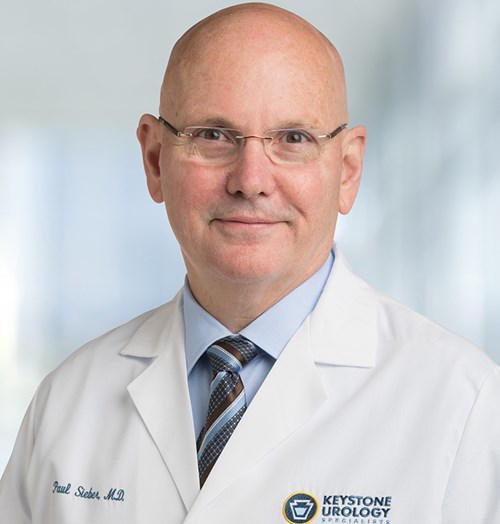
The Advanced Practitioner's Role in Managing Bone Health in Patients With Cancer
Case Study 1
In the first case study, the panel members share their perspectives on managing a patient with a history of advanced castration-sensitive prostate cancer who has developed osteopenia.
Chair

Carrie Tompkins Stricker, PhD, RN, ANP-BC
Thomas Jefferson University

Christine Cambareri,
PharmD, BCPS, BCOP, CSP
University of Pennsylvania
Faculty

Saneese Stephen, MPAS, PA-C
The University of Texas
MD Anderson Cancer Center

Paul Sieber, MD
Keystone Urology Specialists
Transcript
Paul Sieber, MD:
So this is what I've described as kind of the classic patient we're seeing these days. And it's interesting, the evolution of prostate cancer, particularly in the era, at least in my location where the USPSTF's guidelines suggest we don't even screen for it anymore. So we're seeing more and more aggressive cancer diagnosis. And this guy is kind of a case in point that also leads to his bone health questions. So this would be a classic 72-year-old gentlemen who underwent a radical prostatectomy some years ago in the mid 2000s here or 2000 teens. And as many of our patients, unfortunately, they're presenting with more advanced disease. And he suffered a biochemical recurrence within a couple of years after surgery, not an uncommon event. Still in the urologist’s court, though, in terms of management at this point in time.
So the decision was made, which is typical for our practice, he's going to receive at that point, salvage radiation therapy, which is no longer…at least at this point a semi-adjuvant treatment, and a short course of androgen deprivation therapy. In our practice, to start to get the ball rolling he would have been first introduced to our androgen deprivation clinic, which I have the pleasure of having had a nurse practitioner I've worked with now for over 20 years who's the lead person who's part of our team and managing both androgen deprivation and bone health.
So he would have gotten the short course of androgen deprivation therapy, and 6 months is kind of critical because it is a point where he's just starting to diverge from the average. That is, his overall increased risks associated with that are just starting to change at 6 months. So that's based on an article that came out actually about 15 years ago, one of the first articles. It was a New England Journal article, actually, looking at a large CR database that says, "Hey, 6 months is about the time frame when androgen deprivation therapy starts to matter in men," and you start to see the graphs of those patients who are treated with androgen deprivation diverge from those who are not.
But he putzed along, and within a couple of years he's got biochemical recurrence again. And I put down 6 months, meaning, hmmm…he's got our attention, this is a rapid progressor. And we're probably going to think about, or the anxiety will push us to potentially do something at that point in time. And we resume his androgen deprivation therapy. So he's reintroduced to the clinic, a DEXA scan is done, which is part and parcel of what our routine is in that clinic, and it shows osteopenia. So that leads to what's the next step. Carrie?
Carrie Tompkins Stricker, PhD, RN, ANP-BC:
Thanks, Paul. So what is the next step? I think we can have a robust discussion about this. You emphasized some of the key contextual factors here, and you also laid the foundation for a discussion in talking about how his pace of disease has seemed to accelerate here with that PSA doubling time and he does have some bone health risk factors in terms of this osteopenia. He has still what we call at this point castration sensitive prostate cancer. He's still sensitive to hormones. So I'm going to ask you first, Dr. Sieber. What would you do in this situation, since you presented him? Share your side of the story.
Paul Sieber, MD:
Well, in our practice, we have our own protocols set up. And it actually goes back to the fact that managing bone health is not something that's been around forever. While I was looking at zoledronic acid and denosumab, we're only in the roughly 2000 era. And at that time, since I was involved in all those clinical trials, my partners were naive. So it became apparent that even if they would get a DEXA scan and we start off with looking at calcium and vitamin D. And living here in the north, people are very prone to having low levels of vitamin D. So it's routine for us to measure vitamin D, and it's routine for us to have a discussion about calcium. Some of the earlier recommendations from the AUA suggested though, just give them a calcium supplement. Well, that supplement is indicated when they don't meet the National Osteoporosis Foundation guidelines for how much calcium intake they need. So there's no benefit to give them excess of calcium.
So we start with the discussion about their diet. We start off with a discussion about their vitamin D. We start off with a discussion about simple things, like I call childproofing your house. Getting the thought process. You don't want to have a throw rug. Do you have nightlights? You need to make some lifestyle adjustments, and that's down there under fall prevention. And that's again, fall into having a protocol in place that, again, we're discussing on a routine basis. The question about pharmacologic manipulation becomes a little more complex. This gentleman is a...I call them a tweener. Yeah. He doesn't have frank osteoporosis, which clearly gets into the point where he must have manipulation. There's data suggesting he's at risk. So it's kind of a risk/benefit, at least the discussion with this particular gentleman about where he is. And I think it's a little helpful also to dwell on things like family history. And we tend to aggressively look at the FRAX score to also get an idea besides just bone density.
Carrie Tompkins Stricker, PhD, RN, ANP-BC:
Excellent points. Just to follow up on some of them before putting this out there for further discussion, the FRAX or F-R-A-X score is a tool that can be used to evaluate risk of...guess what? Fracture. So many of us use that in practice to assess risk. Christine, do you want to add anything to this discussion from your experience at University of Pennsylvania?
Christine Cambareri, PharmD, BCPS, BCOP, CSP:
Sure. Thank you, Carrie. I would way agree with everything that's already been presented, but an area where I've intervened before is simply in just optimizing the calcium and vitamin D management. Oftentimes you tell patients just start calcium, vitamin D, and that aisle in the grocery store, or even that webpage on Amazon, is overwhelming when you search for that. And helping guide patients too. There are different salt forms of calcium and what the right amount would be.
But also I think the bigger take-home point where I've definitely intervened within the prostate cancer population is talking with patients about “more is not always better.” Your body can only absorb a certain amount at a time. And actually it's recommended that you divide the doses throughout the day for optimal absorption for the calcium. And so that small little tidbit can go a long way with them optimizing what they're doing at home. I always hate for people to buy these supplements and products and not take them correctly to not get their biggest bang for their buck, so to speak, especially when it comes to this simple intervention in addition to diet and lifestyle recommendations for their bone health.
Carrie Tompkins Stricker, PhD, RN, ANP-BC:
Thank you for that. And if I may, a follow-up question for you: As a PharmD and an oncology pharmacist, how do you get access to these patients? What is the role of the advanced practice provider here with respect to education, and how do you integrate that into practice?
Christine Cambareri, PharmD, BCPS, BCOP, CSP:
My role as a clinical oncology pharmacy specialist is to sit shoulder to shoulder with oncology providers, physicians, physician assistants, and nurse practitioners, and even shoulder to shoulder with our infusion nurses as well as we see these patients come through clinic for management of their various cancers. Supporting the role of answering drug information questions, helping with chemotherapy order entry and facilitation, counseling patients, getting a lot of supportive care. So my experience with bone health has been more around supportive care management, pain management, finding the right supplements, talking about which supplements are safe in the context of a patient's cancer and chemotherapy, and also optimizing the ones that are available for them to purchase and buy, and even helping them identify which would be the right one for them.
Carrie Tompkins Stricker, PhD, RN, ANP-BC:
Such excellent points, and really emphasizes the role of the multidisciplinary team here and advanced practice providers in particular, in promoting bone health, doing so holistically and in a way that helps to ensure adherence.
So now our gentlemen has developed biochemical recurrence. Again, it's the end of 2020. His PSA doubling time is still 6 months and PSA is only 1.6, but he's rising on ADT with a testosterone level less than 20. Dr. Sieber, why don't you take the discussion of the case over from here, including imaging and context? And then we'll discuss.
Paul Sieber, MD:
So imaging level, let's start with the last one first. You're making my life difficult. So that's suddenly exploding in our world because the world of PET imaging is taking off with the approval of the PSMA agents. And that's going to continue to evolve as there's two more on the wings that will be approved over the next few months, it would appear. So the idea of this gentleman having nonmetastatic disease at a rising PSA with rapid doubling time is sort of controversial because he probably has mets, we just can't see it. And he may slowly start to disappear. But regardless, let's assume even if he did have a scan and you see a single solitary little lesion, the thought process may be well the same that you're going to think about giving him enzalutamide. And we'll pick on the fact his imaging showed a metastasis, or even if you would argue he has a small lymph node that you had noticed somewhere that you wouldn't have seen on traditional imaging. We're still going to recommend enzalutamide.So a repeat DEXA, yes. For certain. It's been a couple of years since he has had his last DEXA. Let's assume he's still osteopenic, but he's gone from minus 1.6 to minus 2.3, not yet osteoporotic, but significant decline. That's going to get me excited. We're going to reemphasize, how are you doing with your vitamin D? Are you really taking it? We'll recheck his levels. And at this point we're certainly going to add a pharmacologic manipulation because I think this gentleman has significant risk. He's got bone loss, he's got a new drug that causes falls. He's got a new drug that introduces fracture risks. So for all those reasons, we're going to look at that. And we'll probably think about his DEXA mostly just to assess stability over time, just to see where he is, to see what would his rate of fall was. Because again, it starts to add to the concerns about where we're going with this gentlemen.
Carrie Tompkins Stricker, PhD, RN, ANP-BC:
All really great points. Saneese, want to add anything to the discussion or talk about how things might look different?
Saneese Stephen, MPAS, PA-C:
Absolutely. I agree, the case has progressed now to becoming castrate resistant disease requiring enzalutamide or another agent in terms of therapy prevention of bone metastasis or other metastasis. So a very interesting point. The enzalutamide in phase 2 trials when they looked at in monotherapy, they did not find evidence of bone density loss from enzalutamide as monotherapy. But in combination with ADT and with PROSPER trial, for instance, that looked at nonmetastatic castrate-resistant disease using enzalutamide, there was an 18% risk of fractures. So I agree with Dr. Sieber, that the patient is getting a higher risk of fractures, and a FRAX score would also help in this assessment. If we were continuing this patient on treatment, it would be with a bone targeted agent at this point. And we would not choose monthly dose at this point in terms of monthly one target medication, but still stick to the q6mo or annual dose.
People are living longer with our novel hormonal agents and introducing a monthly dose at this point may submit them for years and years of treatment. And the treatments that have of course side effects so let's get into later in the case. But of course, we're very cognizant about the complications of fractures and skeletal-related events. So there's no cookie cutter approach. You have to risk-assess each patient for their risk factors and what their goals are and their challenges are in terms of doing monthly therapy versus less frequent therapies. And following them very closely. I think it requires a multi-team approach and a discussion with the patient and working closely and finding what's the best fit for them. But in terms of preventing bone health complications, I agree at this point, we definitely need to start a pharmacologic agent.
Carrie Tompkins Stricker, PhD, RN, ANP-BC:
Such important points. Christine, do you want to add any additional context or points of difference in this case?
Christine Cambareri, PharmD, BCPS, BCOP, CSP:
Thanks, Carrie. No, I don't have points of difference, but I would say my function also is a lot is to perform education when patients are starting enzalutamide therapy, for example. And I do heavily counsel on the fall risk and kind of reassessing, as Dr. Sieber said, “childproofing” patient's homes and asking how many of these patients are oftentimes getting up at night to use the bathroom or facilities, be it because of their prostate cancer and/or the enzalutamide therapy itself can cause some GI upset and saying, "How close is your bathroom?" or, "Do you wear socks when you go to sleep or you put slippers on, what's in the way? Is there a dog at the foot of your bed?" Kind of reemphasizing this risk for falls and helping them for oversolve for safety before. It's something that we never want, that phone call or that message, "Patient had a fall and is in the hospital” because of something that we could have done to prevent. And so again, I do spend a lot of time focusing on that. I've even had patients saying, "Why are we talking about this? Let's talk about the drug." And so again, those simple things that play a huge role that are necessarily non-pharmacologic in the role of how we can help these patients with their bone health.
Carrie Tompkins Stricker, PhD, RN, ANP-BC:
Such an incredibly important reminder of those fine points and how important education and holistic management are. Before we move off this part of the case, I just want to go back to two points for clarification and education. One is when Saneese, you talked about every-6-month or annual dosing, the intent there is not that you're at this point using doses and schedules of bone-targeted agents as indicated for bone metastases, but rather for bone density management. Correct?
Saneese Stephen, MPAS, PA-C:
Correct. So these are preventive doses. So and a very interesting point that we didn't follow up on what Dr. Sieber mentioned before, with PSMA scans and other more sensitive scans, we may be identifying bone metastases a lot earlier. However, the data for survival is based on prior scans that were used to deal with bone scans, CAT scans, etc. And so far, we have not had any prospective improvement in survival data or skeletal events from targeting patients in this situation early on in continuous bone therapy. So we're really kind of separating out what we have in terms of existing data, with what we potentially can make from future studies on things like PSMA they'll identify a lot earlier. But the point was to do preventive treatment as the National Osteporosis Foundation recommends for patients with osteoporosis or with osteopenia and risk factors. And he certainly has risk factors now with this therapies. So we would at this point do 6-month or yearly treatments.
And the other point that you mentioned about bone metastases, the patient may have it or may not have it. And in our practice with metastatic disease, we would sometimes not start therapy right away, or start it if the patient has active disease after getting some treatments, especially if they're getting SBRT or some other radiotherapy or cryoablation to bone disease. He may not have any active disease that requires treatment. But again, it's what we see. As was mentioned before, there may be other lesions that we're just not seeing, but again, it's hard to make a quantification of the risk factor because all the risk factor studies are done from previous scans.
